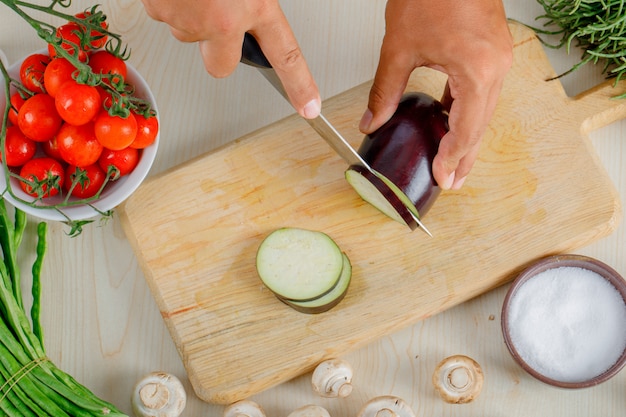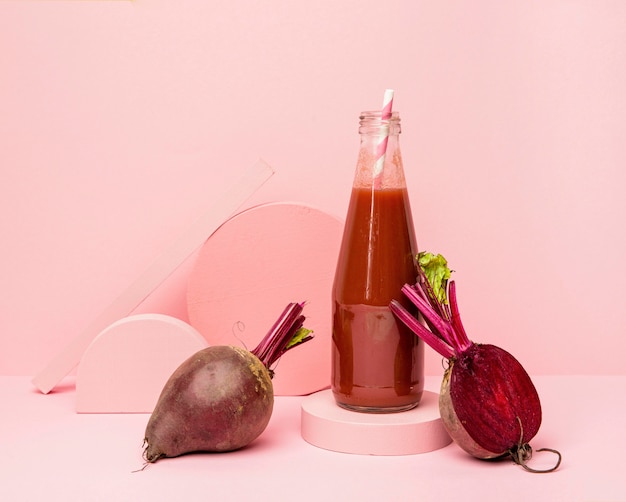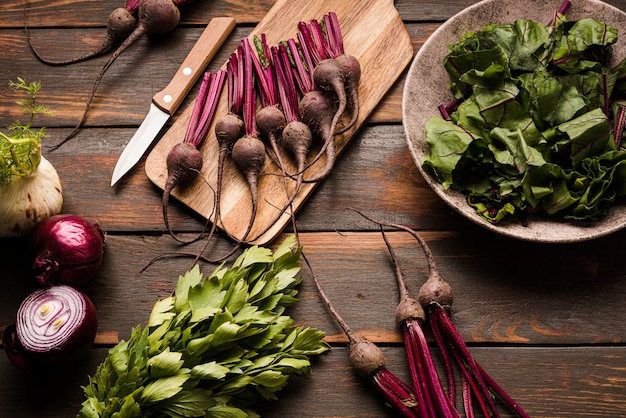Beets are one of those vegetables that always seem to get a bit of a bad rap. Sure, they can be a bit messy to cook and peel, but the payoff is worth it! The earthy sweetness, vibrant colour, and versatility of beets make them a culinary gem. And who doesn't love the deep, rich red colour they add to salads and soups? The problem is, getting them just right can be tricky. You know the feeling: you spend ages boiling them, only to find they're either undercooked and tough or mushy and overcooked. Not a good look, and definitely not what we're going for. After years of trial and error, I've discovered the secrets to consistently achieving perfectly cooked beets – beets that are tender, vibrant, and bursting with flavour. So, grab your favourite pot or roasting pan, and let's embark on a culinary adventure together.
(Part 1) Understanding the Beet

Before we jump into the actual cooking, it's essential to understand the anatomy of the humble beet. Beets are a root vegetable, and they come in various shapes and sizes, with different colours ranging from deep crimson to golden yellow. They even have striped varieties, like the Chioggia beet, that add a splash of colour to any dish. The vibrant colour isn't just for looks; it's also an indicator of the beet's nutritional value, with beets being packed with vitamins, minerals, and antioxidants.
Choosing the Right Beet
As with any vegetable, the key to success starts with choosing the right ingredient. When selecting beets, look for firm, unblemished roots with smooth skin. Avoid any beets that are soft, wrinkled, or have signs of decay. If you're unsure about the freshness, give the beet a gentle squeeze. It should feel firm and springy, not soft or squishy. A good way to tell if a beet is fresh is to check the leaves. They should be bright green and crisp, not wilted or yellowed.
Beet Varieties: The Flavour Spectrum
The world of beets extends beyond just red. Different varieties offer diverse flavour profiles and cooking times. Here are a few examples:
- Red beets are the most common and have a sweet, earthy flavour.
- golden beets have a milder, slightly sweeter flavour with a beautiful golden colour.
- Chioggia beets have distinctive red and white stripes and a slightly tangy, sweet flavour.
- Baby beets are small and tender, cooking much faster than their larger counterparts.
Experiment with different varieties to discover your favourite flavours and cooking techniques.
Preparation: A Foundation for Success
Before cooking, a bit of preparation goes a long way. Scrub the beets thoroughly under running water to remove any dirt or debris. There's no need to peel them at this stage, as the skin helps retain moisture during cooking. You can trim the greens, leaving about an inch of stem attached. The greens are packed with nutrients and can be used in salads, stir-fries, or even blended into smoothies.
(Part 2) Cooking Methods: Exploring the Options

Now that we've chosen our beets and prepared them, let's dive into the cooking methods themselves. Each method offers unique flavour profiles and textures, so experiment and discover your favourites.
Boiling: The Classic Technique
Boiling is the most straightforward method for cooking beets. It's simple, reliable, and allows the beets to retain their vibrant colour. However, it's important to get the boiling time right to prevent overcooking.
Boiling Beets: A Step-by-Step Guide
- Fill a large pot with enough water to cover the beets.
- Bring the water to a rolling boil, then reduce the heat to a simmer.
- Add the beets to the simmering water and cook for 30-45 minutes for medium-sized beets or 15-20 minutes for baby beets.
- Check for doneness by inserting a fork into the thickest part of the beet. If the fork goes in easily and the beet feels tender, it's ready.
- Once the beets are cooked, immediately transfer them to a bowl of ice water to stop the cooking process.
Tips for Boiling Beets:
- Add a tablespoon of vinegar to the water to help retain the beets' vibrant colour.
- Don't overcrowd the pot, as this can prevent the beets from cooking evenly.
- Keep an eye on the water level and add more if necessary to ensure the beets are fully submerged.
Roasting: Elevating the Flavour
Roasting beets brings out their natural sweetness and creates a more concentrated flavour. It also adds a slight caramelization that adds a touch of depth to the beets' earthy profile.
Roasting Beets: A Step-by-Step Guide
- Preheat your oven to 400°F (200°C).
- Wash and trim the beets, leaving the skin on.
- Wrap each beet in foil, making sure to seal the edges tightly.
- Place the wrapped beets on a baking sheet and roast for 45-60 minutes for medium-sized beets or 30-45 minutes for baby beets.
- Check for doneness by piercing the beet with a fork. It should feel tender.
- Once cooked, remove the beets from the oven and let them cool slightly before unwrapping.
Tips for Roasting Beets:
- Add a tablespoon of olive oil, salt, and pepper to the foil for extra flavour.
- Don't overcrowd the baking sheet, as this can prevent the beets from roasting evenly.
- For a crispier finish, remove the foil for the last 15 minutes of roasting.
Steaming: A Healthy Option
Steaming is a healthier way to cook beets as it preserves more nutrients than boiling. It also gives the beets a slightly lighter flavour.
Steaming Beets: A Step-by-Step Guide
- Fill a large pot with water and bring it to a boil.
- Place the beets in a steamer basket and place the basket over the boiling water.
- Steam the beets for 30-45 minutes for medium-sized beets or 15-20 minutes for baby beets.
- Check for doneness by piercing the beet with a fork. It should feel tender.
- Once the beets are cooked, remove them from the steamer basket and let them cool slightly.
Tips for Steaming Beets:
- Add a few sprigs of fresh herbs to the steaming water for a more aromatic flavour.
- Don't overfill the steamer basket, as this can affect the steaming process.
- Use a timer to ensure the beets don't overcook.
(Part 3) The Telltale Signs of Doneness: How to Know When They're Ready

One of the most common challenges with cooking beets is knowing when they're cooked through. You don't want them to be undercooked and tough, but you also don't want them to be overcooked and mushy. Here are a few methods to ensure your beets are cooked to perfection:
The Fork Test: A Foolproof Method
The most reliable way to test for doneness is with a fork. Insert the fork into the thickest part of the beet. If it goes in easily and the beet feels tender, it's ready. If the fork encounters resistance, the beet needs more cooking time.
The Skin Check: A Visual Indicator
While not as accurate as the fork test, you can also check the skin of the beet. If the skin is starting to loosen, the beet is likely cooked. However, this method can be unreliable, as some beet varieties have thinner skins that may loosen even before the beet is fully cooked.
The Colour Test: Boiling Beets Only
For boiling beets, you can also check the colour of the water. When the water turns a deep red, the beets are likely cooked through. However, this method is less reliable for other cooking methods, such as roasting or steaming.
(Part 4) Cooling and Peeling: The Final Touches
Once your beets are cooked, it's time to cool and peel them. Cooling stops the cooking process and makes peeling easier. Here's what you need to do:
Cooling Down: Preventing Overcooking
Immediately transfer the cooked beets to a bowl of ice water. Allow them to cool for at least 15 minutes. This will shock the beets, stopping the cooking process and making them easier to peel.
Peeling with Ease: Tips for a Smooth Process
After cooling, the skins should slip off easily. Use a paring knife or your fingers to peel the beets. If the skins are stubborn, try rubbing them with a paper towel to loosen them up.
Stain Prevention: Keeping Your Hands Clean
Beets are notorious for staining hands, so it's best to wear gloves while peeling them. Alternatively, use a kitchen towel to hold the beets while peeling. If you do get stains on your hands, a bit of lemon juice or vinegar can help remove them.
(Part 5) Storage: Preserving Freshness and Flavor
Once peeled, cooked beets can be stored in the refrigerator for several days. Here's how to make sure they stay fresh and flavorful:
Refrigerator Storage: Up to 5 Days
Store cooked beets in an airtight container in the refrigerator for up to 5 days. They can be stored whole or chopped.
Freezing for Later: Up to 3 Months
To freeze cooked beets, place them in a single layer on a baking sheet lined with parchment paper. Freeze for about 2 hours, or until solid. Transfer the frozen beets to a freezer-safe bag or container. When ready to use, thaw the beets in the refrigerator overnight or at room temperature.
(Part 6) Versatility: A World of Possibilities
The beauty of beets lies in their versatility. They can be enjoyed in countless ways, from simple salads to elaborate dishes. Here are a few ideas to get your creative juices flowing:
Salads: A Vibrant Addition
Beets add a burst of colour and sweetness to salads. Try them in a simple beet salad with goat cheese, walnuts, and a balsamic vinaigrette, or pair them with roasted chickpeas, feta cheese, and a lemon dressing.
Soups: Earthy Sweetness
Beets are a delicious addition to soups. Their earthy sweetness complements creamy soups like beetroot and goat cheese soup or roasted red pepper and beetroot soup. For a more vibrant flavour, try a beet and ginger soup with a touch of lime juice.
Sides: A Stunning Accompaniment
Roasted or steamed beets make a stunning side dish. Serve them with roasted chicken, salmon, or a hearty steak. You can also add a touch of sweetness by drizzling them with maple syrup or honey.
Main Courses: The Star of the Show
Beets can even be the star of the show. Try making a beet burger with quinoa and black beans, or create a delicious beet and lentil stew. For a vegetarian option, try a beetroot and ricotta tart.
Desserts: Unleashing Creativity
Don't be afraid to experiment with beets in desserts! Their natural sweetness lends itself well to cakes, cupcakes, and even ice cream. Try a beet and chocolate cake, a beet and carrot cupcake, or a beet and ginger ice cream.
(Part 7) FAQs: Addressing Your Questions
1. What are the best beets for cooking?
There are many varieties of beets available, each with its unique flavour and texture. Some popular choices for cooking include:
- Red beets: These are the most common type and have a sweet, earthy flavour.
- Golden beets: These have a milder flavour and a vibrant golden colour.
- Chioggia beets: These have a distinctive striped pattern and a slightly tangy flavour.
- Baby beets: These are smaller and have a more tender texture. They cook faster than larger beets.
Ultimately, the best beet for you depends on your personal preference.
2. Why do my beets bleed when I cook them?
Beets naturally contain a red pigment called betalain. When beets are cooked, the betalain is released into the water, creating a vibrant red colour. This bleeding is a natural process and doesn't affect the flavour or texture of the beets.
3. Can I eat the beet greens?
Absolutely! Beet greens are packed with nutrients and can be used in a variety of dishes. They have a slightly earthy flavour and can be cooked like other leafy greens. Try them in salads, stir-fries, or soups.
4. Can I store cooked beets in the freezer?
Yes, you can freeze cooked beets. Freeze them in a single layer on a baking sheet lined with parchment paper, then transfer them to a freezer-safe bag or container. Frozen beets can be stored for up to 3 months. To use, thaw the beets in the refrigerator overnight or at room temperature.
5. How long does it take to cook beets?
The cooking time for beets varies depending on the size, variety, and cooking method. Generally, medium-sized beets take around 30-45 minutes to cook. Baby beets cook much faster, usually in 15-20 minutes.
Here is a table summarizing the cooking times for different beet sizes and methods:
| Cooking Method | Medium Beets | Baby Beets |
|---|---|---|
| Boiling | 30-45 minutes | 15-20 minutes |
| Roasting | 45-60 minutes | 30-45 minutes |
| Steaming | 30-45 minutes | 15-20 minutes |
Remember, these are just general guidelines. Always check for doneness using the fork test to ensure your beets are cooked to your liking.
(Part 8) The Joy of Beet Cooking: A Final Thought
Cooking beets might seem like a daunting task, but with a little knowledge and practice, it can be a joy. Embrace the journey, experiment with different methods, and discover your own favourite ways to enjoy this vibrant, versatile vegetable. From simple salads to elaborate dishes, beets add a touch of colour, sweetness, and nutritional value to any meal. So, next time you're looking for a delicious and healthy ingredient, reach for a bunch of beets and get ready to unleash your culinary creativity.
Everyone is watching

Corn on the Cob: The Ultimate Guide to Perfectly Cooked Ears
Healthy MealsAh, corn on the cob. Just the name evokes images of sunny days, barbecues, and that sweet, juicy flavour that ...

Perfect Pork Roast Oven Cooking Time: A Guide to Delicious Results
Healthy MealsThere's something truly satisfying about a perfectly roasted pork. The aroma alone is enough to make your mout...

Ham Cooking Time: How Long to Bake, Smoke, or Boil a Delicious Ham
Healthy MealsAh, ham. It's a classic, isn't it? A real crowd-pleaser, especially around holidays. And when done right, it'...

Scallops: The Ultimate Guide to Perfect Cooking
Healthy MealsAh, scallops. Those delicate, sweet, and utterly delicious morsels of the sea. They hold a special place in my...

Spaghetti Squash: The Ultimate Guide to Cooking and Serving
Healthy MealsRemember that time you saw spaghetti squash at the supermarket, looking all bumpy and strange, and thought, "W...
